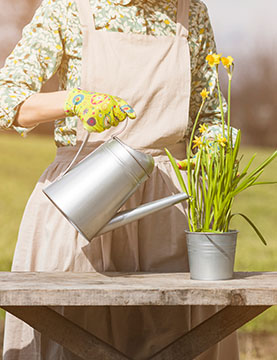Springtime is Planting Time
Spring has finally, officially arrived after the craziest weather imaginable this past year. Of course, we can say that every year. It is the perfect time to add new plants to your landscape or replace those lost to the heat and drought of the last few summers or the snow and freezing temperatures of the last few winters. Here are a few helpful tips to remember when you buy plants to make sure your new plants survive and flourish in your landscape.
- Make sure the plants are well rooted but not root bound.
- Choose plants with lush but compact foliage and avoid leggy and overgrown plants. The crown should be no more than three times the size of the container.
- Never buy wilted plants. Under watering causes wilting, repeated under watering weakens plants so much that they never fully recover.
- Avoid plants with yellow or brown foliage. They either have dried out from lack of water or have disease problems.
- If you cannot plant immediately, keep plants well watered, in the shade and out of the wind until you can get them in the ground.
- Buy plants that are loaded with buds, not blooms. If you want the plants to bloom in your yard and not just the nursery, look for plants with lots of buds.
- Grow a large variety of plants. For a truly healthy attractive landscape, variety is the key. Plant a little of everything including trees, shrubs, ornamental grasses, evergreens, spring and summer bulbs, annuals, perennials and herbs. A mixture of plants in your landscape will attract an assortment of butterflies, birds and beneficial insects for you to enjoy.
- Pick the right plant for the right place. Know if the plant needs sun or shade. If it says, "May need part shade." that means that in hot climates; it definitely needs some shade, especially in the afternoon.
- Check the mature size of the plant. That one-gallon container plant may eventually get 15' tall and wide.
- Plant correctly by digging a hole about 2 or 3 times as wide as the root ball. The hole should only be as deep as the top of the root ball. You are planting, not burying, the plant.
- Water new plants well and often – even drought tolerant varieties need more water until they are established. Do not sprinkle – water thoroughly so the roots grow deep.
- MULCH EVERYTHING. Just a 3" to 4” layer of mulch conserves moisture, regulates soil temperatures, smothers weeds and breaks down to build soil fertility and feed the plants. Mulch also makes the garden look tidier and more attractive. Do not buy cheap, dyed mulch - you do not know where it came from and it is likely ground up pallets that could contain harmful chemicals and diseased wood. Plants have a hard enough time surviving summer heat without putting black mulch around them, which actually absorbs more heat that reflects back onto the poor plants.
The following is a list of some great plants (many are native) that will grow easily over a large area of climate zones. I garden in Zone 7; however, I like to use plants that cover several zones, especially zones that get colder than zone 7. Always check the zones listed on labels or in plant specifications when buying to make sure they will grow well in your zone. Here is a link to the USDA hardiness zone map: https://planthardiness.ars.usda.gov/PHZMWeb/
These plants also have plant growth and traits that are really important to gardeners since they do not need a lot of pruning or staking, will survive high summer heat, won’t take over your whole yard, bloom for a long time and look good when they are not blooming. Most of them also attract butterflies, birds and hummingbirds and are easy to find locally and online. That is a lot to ask of a plant, but these will not disappoint you.
- Trees: Arizona Cypress, Bosnian Pine, Caddo Sugar Maple, Chinese Pistache, Crabapple ‘Prairiefire’, Kentucky Coffee Tree, Lacebark Elm, Red Bud ‘Oklahoma’, River Birch ‘Heritage’, Shantung Maple, Shumard Oak
- Shrubs: Abelias, Artemesia 'Powis Castle', Crepe Myrtles, Deciduous Holly/Possumhaw, Burford Hollies, Dwarf Nandinas, Spireas, Vitex, Yaupon Hollies
- Perennials: Autumn Sage, Black-eyed Susans, Cannas, Catmint, Coreopsis, Daisy 'Becky', Daylilies, Gaillardias, Garden Phlox, Hardy Hibiscus, Hosta 'So Sweet' (SHADE), Lantanas, Liatris, Malvas, Mexican Feather Grass, Perovskia (Russian Sage), Purple Coneflowers, Salvias, Sedums, Veronicas, Yarrows
- Annuals: Angelonia, Castor Bean, Celosia, Cleome (reseeds), Cosmos, Gaillardia 'Arizona Sun', Golden Crownbeard (reseeds prolifically), Larkspur (reseeds), Melampodium, Nicotiana (Flowering Tobacco - reseeds), Pentas, Purple Fountain Grass, Sun Coleus, Sweet Potato 'Margarita', Zinnias (reseed)

 Member Login
Member Login






